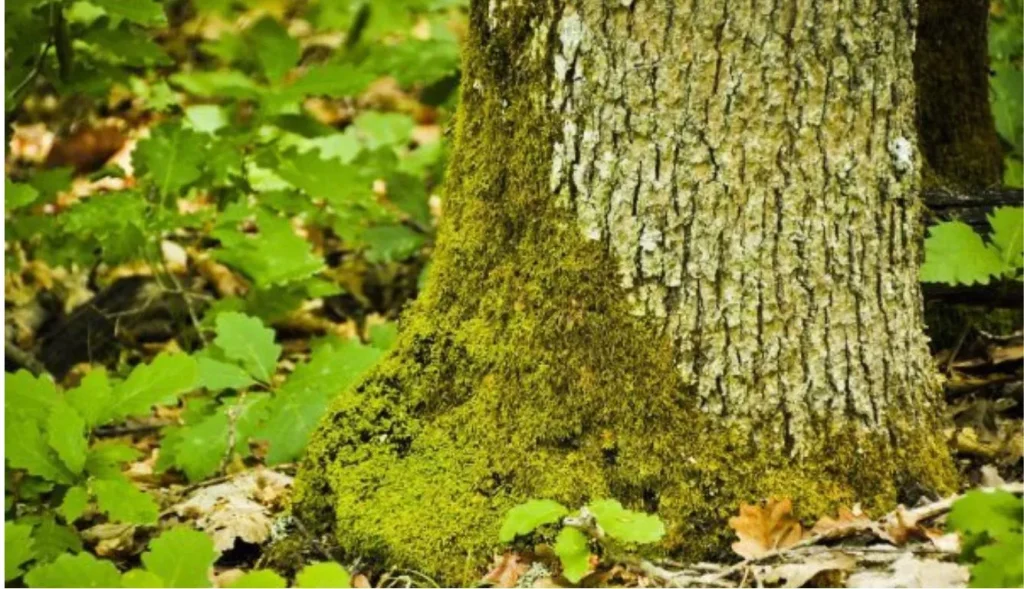Introduction
Keeping your trees healthy and vibrant is essential not just for their longevity but also for the overall aesthetics of your garden. One common issue many tree owners face is the growth of moss. While moss can lend a rustic charm to your landscape, it can also cause several problems for your trees if not managed properly. In this article, we’ll explore how to get rid of moss on trees, ensuring your greenery remains lush and healthy.

Understanding Moss
What is Moss?
Mosses are small, non-vascular plants that typically form dense green clumps or mats in shady, damp environments. Unlike many other plants, mosses don’t have roots but anchor themselves with tiny, threadlike structures called rhizoids.
Types of Moss Found on Trees
Several types of moss can grow on trees, including common varieties like cushion moss, feather moss, and sheet moss. Each type has a unique appearance and growth pattern, but they all thrive under similar conditions.
Conditions That Promote Moss Growth
Moss tends to flourish in environments that are moist, shaded, and cool. Trees with dense canopies that block sunlight, areas with poor air circulation, and regions with high humidity levels are particularly susceptible to moss growth.
Impact of Moss on Trees
Is Moss Harmful to Trees?
Generally, moss is not harmful to trees. It does not parasitize trees or steal nutrients from them. However, excessive moss growth can lead to issues such as increased moisture retention against the bark, which may promote fungal infections or attract pests.
Benefits of Moss
Mosses can provide benefits such as creating habitats for beneficial insects and contributing to the overall ecosystem of your garden. They can also help with soil stabilization and erosion control.
Potential Problems Caused by Moss
Excessive moss growth can cause several problems, including:
- Increased moisture retention: This can lead to rot and fungal diseases.
- Added weight: Heavy moss can stress branches, especially during storms.
- Aesthetic concerns: Thick moss can obscure the natural beauty of your trees.
Preventing Moss Growth
Choosing the Right Location for Planting
Select planting sites that receive adequate sunlight and have good air circulation. Avoid overly shaded areas or locations prone to waterlogging.
Pruning for Better Air Circulation
Regular pruning helps ensure that sunlight reaches all parts of the tree and improves air circulation, making the environment less favorable for moss growth.
Regular Tree Maintenance
Routine maintenance, such as cleaning fallen debris and ensuring proper drainage, can help prevent moss from taking hold.
Manual Removal of Moss
Tools Needed for Moss Removal
You’ll need a few basic tools for manual moss removal, including:
- A stiff brush or broom
- Garden gloves
- A ladder (for tall trees)
Step-by-Step Guide to Manually Removing Moss
- Safety First: Ensure you have a stable ladder and wear appropriate safety gear.
- Gently Brush Off Moss: Use a stiff brush or broom to gently scrub the moss off the bark. Be careful not to damage the bark.
- Dispose of Removed Moss: Collect and dispose of the moss properly to prevent it from spreading.
Safety Precautions
Always be cautious when using a ladder and working at heights. Consider having someone assist you to ensure stability and safety.
Chemical Treatments
Types of Chemical Treatments Available
There are various chemical treatments available, including moss killers and fungicides specifically designed for trees.
How to Apply Chemical Treatments
- Read Instructions: Follow the manufacturer’s instructions carefully.
- Apply Evenly: Spray the chemical treatment evenly across the affected areas.
- Monitor the Tree: Check for any adverse reactions and ensure the moss is dying off.
Environmental Considerations
When using chemical treatments, be mindful of their potential impact on the environment. Opt for eco-friendly products whenever possible and avoid over-application to minimize runoff.
Natural Remedies
Homemade Solutions for Moss Removal
Several natural remedies can effectively remove moss, such as:
- Baking Soda Solution: Mix baking soda with water and spray on the moss.
- Vinegar Solution: Dilute vinegar with water and apply to mossy areas.
Benefits of Natural Remedies
Natural remedies are generally safer for the environment and non-toxic to other plants and animals in your garden.
Application Methods
Apply the solution using a spray bottle, ensuring thorough coverage of the moss. Repeat as necessary until the moss is eradicated.
Maintaining Tree Health Post-Removal
Regular Inspections
Regularly inspect your trees for any signs of moss regrowth or other issues. Early detection makes management easier.
Ongoing Tree Care Tips
Continue with regular pruning, cleaning, and maintenance to keep your trees healthy and moss-free.
Signs of Moss Regrowth
Look for small patches of green or fuzzy growth on the bark, especially in shaded, damp areas of the tree.
When to Seek Professional Help
Situations That Require Expert Intervention
If the moss growth is extensive, hard to reach, or if you notice signs of tree health decline, it’s time to call in a professional.
Choosing a Tree Care Professional
Look for certified arborists with good reviews and experience in dealing with moss and tree health.
What to Expect from Professional Services
Professional services typically include a thorough assessment of your tree’s health, customized treatment plans, and ongoing maintenance recommendations.
FAQs
How often should I check my trees for moss?
Regular inspections every few months can help you catch moss growth early and manage it effectively.
Can moss removal harm my trees?
If done carefully, moss removal should not harm your trees. Avoid damaging the bark during the removal process.
What are the best tools for removing moss?
A stiff brush or broom, garden gloves, and a stable ladder are essential tools for manual moss removal.
Are chemical treatments safe for the environment?
Some chemical treatments can be harmful, so it’s important to choose eco-friendly products and apply them as directed to minimize environmental impact.
How can I prevent moss from growing back?
Regular pruning, maintaining good air circulation, and choosing the right planting location can help prevent moss from regrowing.
Conclusion
Maintaining the health and beauty of your trees is crucial, and managing moss growth is an important aspect of this. By understanding moss, its impact, and the various removal methods, you can keep your trees thriving. Whether you opt for manual removal, chemical treatments, or natural remedies, regular maintenance and early intervention are key.


Congratulation!